30 Top Branding Statistics For 2024
Looking for some insight into what makes a good brand? We’ve got you covered with this list of branding statistics for 2023.
Branding can have a huge impact on sales and on the success of your business.
But with consumer preferences and expectations constantly changing, it can be hard to keep your finger on the pulse and choose the right branding strategy.
That’s why we’ve created this list of 30 branding statistics. We cover everything from the best colors to use to how to build a brand that consumers can trust.
Editor’s top picks
- Over 60% of people form emotional attachments to brands they love. (Salesforce)
- Almost 90% of customers value the authenticity of brands when choosing where to shop. (BusinessWire)
- Almost 80% of consumers would choose not to purchase from brands based on where the company is based. (Edelman)
- 77% of consumers buy from brands they follow before buying from other stores and brands. (Sprout Social)
- Blue is the most common color used in branding by global companies. (Reboot online)
General branding statistics
Branding is key to forming strong B2C relationships, so it’s important to create a good brand image and give off the right signals. Here are some general branding statistics that evidence the importance of good branding.
1. 62% of customers feel emotionally attached to their favorite brands
How you brand your business can have a huge impact on the way customers interact with it. Many people see brands as more than just stores to buy things from, they actually create strong bonds and attachments to companies that they have positive experiences with.
According to Salesforce, 62% of customers reported that they feel emotionally attached to the brands that they love, and this is all a result of good branding. Anything can contribute to this, from positive interactions with service staff to love for the products or even viral social media campaigns.
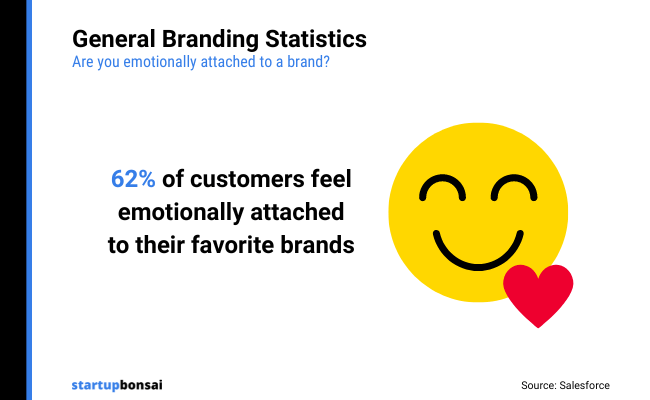
Source: Salesforce
2. 32% of customers will research consumer opinions about a brand before buying products from them
Brand reputation is extremely important as it can impact not only your relationships with previous customers but also with new customers too. According to Salesify, 32% of new customers will research other consumer opinions when they are considering buying from your brand.
If your branding is on point, then this conscientiousness from consumers will help to bring new customers to your business. However, it’s extremely important to monitor your own brand presence online to ensure that customers are sharing positive feedback about your products and services
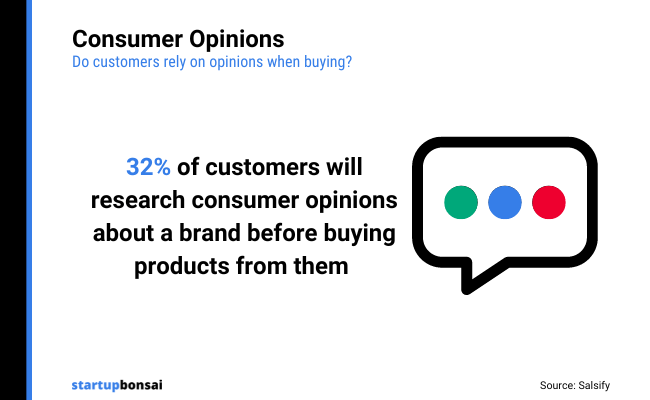
Source: Salsify
3. 56% of consumers are more likely to buy from brands that have a loyalty program
Customers love brands that can make them feel like they are part of an elite club, and rewarding customer loyalty is a great way to implement this. According to Salesforce, more than half of consumers said they are more likely to buy from brands if they have a loyalty program in place.
Loyalty programs not only help to strengthen relationships with customers, but it also makes customers more likely to choose your brand over competitors.
However, it’s important to offer decent perks and discounts to loyalty program members that will make them feel valued. Very small discounts or rewards that lack real value could actually turn customers away from your brand if they feel that their loyalty isn’t being adequately rewarded.
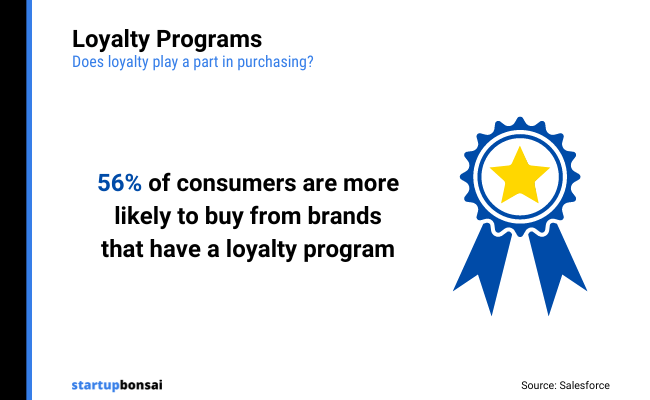
Source: Salesforce
4. 55% of people are more likely to buy a product if they love a brands story
Contrary to the beliefs of many stores and marketers, consumers really are interested in investing in brands and the stories behind them. According to Marketsmiths, over half of consumers said a good brand story would make them more likely to buy a product.
When sharing your brand story, ensure that it is authentic and really speaks to your target audience. People love to learn more about the workers of companies, the ethos, and the thinking behind product creation.
It’s also a good idea to share information such as where products and ingredients are sourced and how the company is hoping to make a social or ethical impact. Brand stories are what set competing businesses apart, so it’s a good idea to proudly display your story on your websites and socials instead of burying it away on the About page on your site.
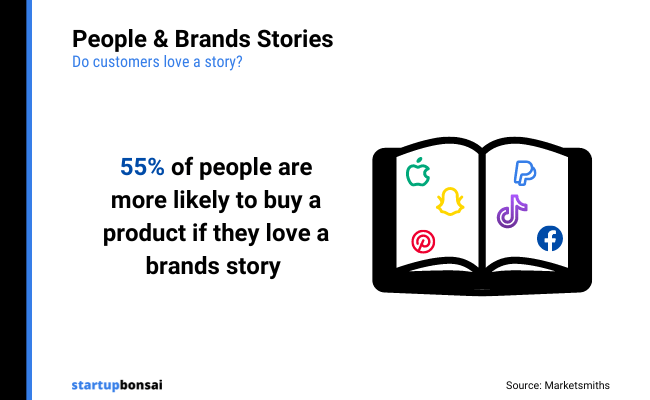
Source: Marketsmiths
5. Almost 70% of consumers would like brands to provide a personalized shopping experience
Consumers don’t like to buy from faceless or generic brands, and with the advancement of online shopping, personalized experiences are becoming more important for shoppers.
When surveyed by BusinessWire, 68% of consumers said they would like brands to provide a more personalized shopping experience, and this is another great way of building strong customer relationships and a good brand image.
There are tons of ways to personalize shopping experiences, especially if you’re an ecommerce store, and making just a few adjustments to make the customer experience more personalized can have a huge impact on brand sentiment overall.
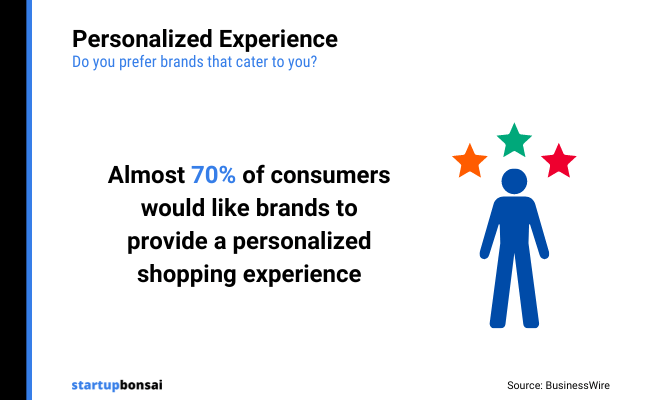
Source: BusinessWire
6.55% of consumers are likely to consider the environmental impact of the products they buy
Environmental impact is a hot topic for consumers this year, and it’s becoming more important as climate issues become more prevalent. When choosing what products your brand sells and how they are created, it’s extremely important to consider their environmental impact.
According to Edelman, over half of customers consider environmental impact before they make a purchase. So, if your product isn’t environmentally conscious, you could lose sales and garner negative reviews from customers.
Source: Edelman
7. 71% of people said environmental practices influence their opinion of brands
In the same way that consumers are concerned about the environmental impact of products, they are also interested in a business’s environmental practices overall, and they can have a big impact on consumer opinion.
71% of people told Salesforce that environmental practices are likely to impact their overall opinion of the brand, so it’s important for brands to take steps to become environmentally conscious.
Unfortunately, it isn’t enough to simply stay quiet and not publicize environmental policies, as this can also negatively impact your brand image. The best brands take steps to be as eco-friendly as possible and make an effort to be transparent about their environmental impact
Source: Salesforce
8. 77% of people said they would not buy from brands based on the countries that the brand headquarters are based
Interestingly, Edelman also found that the location of a business’s headquarters can have a big impact on brand image and sales.
According to the study, 77% of people based their purchasing decision on where the brand headquarters are located. If they are located in countries outside of where they live, people are less likely to buy from that brand overall.
For brands, this is extremely significant. If you have a company that is based outside of where most of your target audience lives, it could impact your brand and sales figures a lot.
Source: Edelman
Brand trust statistics
In almost every branding study or report, trust and authenticity are mentioned by customers as the most important elements of good branding. Here are some statistics relating to building brand trust.
9. 88% of people say authenticity is key when deciding what brands to shop with
When shopping online or on the high street, consumers have a lot of options to choose from. However, one of the key factors that help shoppers to decide which brand to choose is authenticity.
Around 90% of people told BusinessWire that authenticity was extremely important to them when deciding where to shop. For brands, this means that being open and honest with customers about prices and policies and providing good reliable service is essential in order to compete with other similar companies.
Companies with strong brand values and a well-established brand identity are often seen as the most authentic by consumers.
Source: BusinessWire
10. 79% of GenZ customers say it is more important to buy from brands they trust than ever before
GenZ is currently the youngest generation of consumers, and they seem to have specific preferences when it comes to shopping and choosing brands. This social media generation is constantly bombarded with ads for low-quality viral products, which has led to a rise in younger consumers searching for trustworthy brands.
According to an Edelman study, almost 80% of GenZ consumers said that it is more important to buy from trustworthy brands than ever before. GenZ shoppers make up a big part of the current consumer market which is why building a trustworthy brand is so important for businesses this year.
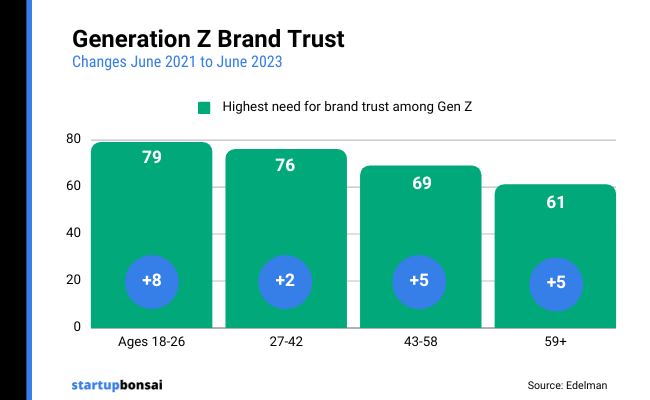
Source: Edelman
11. 46% of US consumers are willing to pay a higher price for products in order to buy from a brand they trust
One of the biggest concerns that companies have about branding is the cost. Many companies are unwilling to invest in branding services if they can’t see a direct ROI. However, this is a big mistake in some cases. Building a trustworthy brand can actually mean that consumers are willing to pay more for products, so the costs of branding can be offset in this way.
According to Salsify, almost half of US consumers are willing to pay more for products if it means they can buy from brands that they trust
Source: Salsify
12. 77% of consumers trust brands that make honest claims about products or services
One of the easiest ways to establish a trustworthy brand image is to simply tell the truth.
Shocking, right?
According to Salesforce, almost 80% of consumers will trust brands if their products and services live up to the claims made about them.
This means simply taking accurate product photos and writing informative and honest product descriptions is the best way to build trust with consumers.
In addition to this, 71% of customers told Salesforce that they trust brands that make honest claims about social initiatives, and 68% responded that they trust brands that ‘tell the truth’ generally.
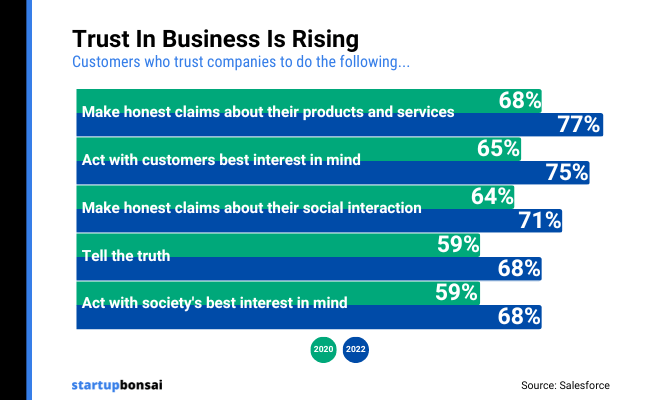
Source: Salesforce
13. 96% of consumers say excellent service is the best way to build brand trust
Good branding isn’t all about social media campaigns and elaborate brand stories. In fact, one of the easiest ways to build brand trust is to offer great service to your customers.
96% of people told Salesforce that excellent service is the best way to build brand trust, and this is remarkably easy for businesses to achieve.
Of course, larger companies may need to invest in new staff and training to up their service levels, but for smaller businesses, it’s comforting to know that the simple tactic of offering great service to customers is one of the best ways to establish a reliable brand.
Source: Salesforce
14. 34% of consumers strongly agree that brands should use their platform to raise awareness for causes and take a clear stance on sensitive topics
Many brands try their best to opt out of social conversations and awareness raising in an effort to appeal to as many customers as possible. However, saying nothing can sometimes steer customers away too.
According to Sprout Social, 34% of customers strongly agree that brands should have their say when it comes to sensitive social topics and do what they can to raise awareness for good causes.
Speaking out and involving your brand in social conversations is a great way of establishing a strong brand ethos and building up a positive reputation, particularly in the ethically conscious world that we currently live in.
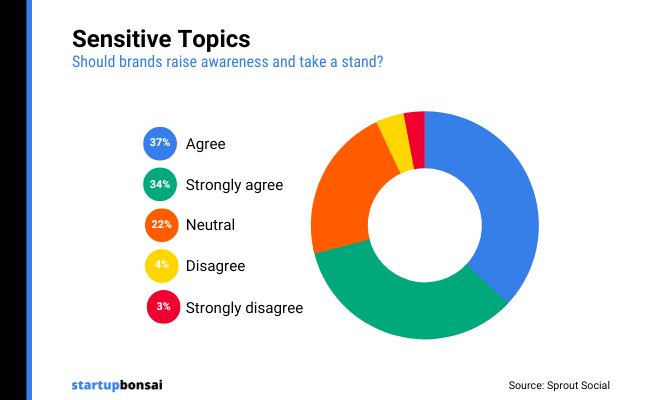
Source: Sprout Social2
15. 73% of consumers were attracted to brands that increased their sense of safety and security
In addition to trust, consumers also value brands that make them feel safe and secure when shopping. On average, 73% of consumers said they were attracted to brands that offered a sense of safety and security.
However, it seems that this is most important to older consumers. In the 43-58 age bracket, 73% reported safety and security as an attractive brand trait. And amongst 58+ year-olds, 83% said that this was important. So if you have an older target market, then providing safe and secure shopping options is essential for good branding.
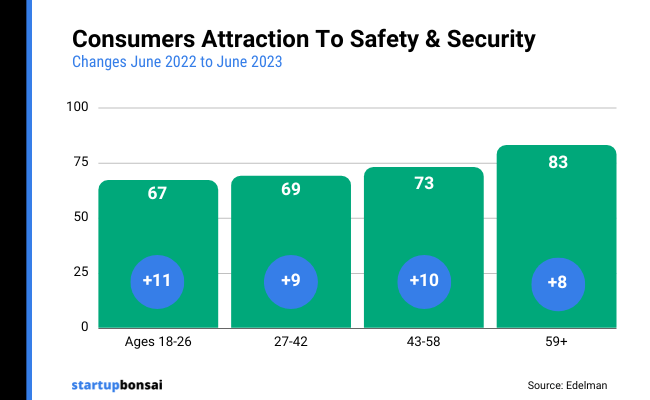
Source: Edelman
16 .67% of customers will stay loyal to and advocate for brands that they trust
Creating a strong brand with loyal customers can impact the success of a business in many different ways. In fact, it can even lead to customers working to advocate for the brands they love.
According to Eldman, 67% of consumers will stay loyal and advocate for brands they trust, which further evidences the importance of building a trustworthy brand image
Source: Edelman
Branding design statistics
Branding is more than just your company’s conduct and ethos. Design elements are also very important when building a reputable and recognizable brand. Here are some branding design statistics that can help you learn more about brand colors, names, logos, and websites.
17. Using a signature color can improve customer recognition of your brand by up to 80%
Branding colors are often selected quickly and without much thought, but they can have a huge impact on branding and recognition. The color you choose can help to make your brand more memorable and recognizable.
According to Reboot, choosing a signature color that is synonymous with your brand is a good choice, as it can increase brand recognition of your brand by up to 80%
Source: Reboot Online
18. 30% of global companies use blue in their logo
The colors you choose for your branding can have quite an impact on the way consumers feel about your brand. One of the most common colors used in branding and logos is blue.
According to Reboot Online, around 30% of companies use blue in their logo. Blue is well known as a reliable color and is often used to evoke stability by corporate businesses. It can also be associated with wealth and luxury.
Similarly, red is used in 30% of global logos and is associated with passion and food, which is why it’s used by a lot of fast-food chains.
Unpopular colors for branding include brown and orange, which are used in only 2% of global company logos and 5%, respectively.
When choosing your branding colors, it’s a good idea to consult a color psychology guide to ensure that you’re sending out the right message to your audience.
Source: Reboot Online
19. 91% of consumers can identify the Google logo by colors alone
Colors are so important that many people can identify a brand using only the colors from their logo. For example, 91% of customers can identify Google based only on the colors in their logo.
For this reason, it’s important to choose the right brand colors from the get-go, as rebranding and changing colors further down the line could negatively impact brand image and recognition.
Source: Reboot online
20. 75% of people judge a brand’s credibility based on web design elements
When building a credible brand, it’s also important to have a professionally branded website for your customers to access. According to Kinesis Inc, 75% of people judge brands based on web design which is why it’s so important to get it right.
A well-branded website should amplify the brand’s story and include brand colors, as well as be a safe, secure, and reliable site to access.
Source: Kinesis Inc
21. Hyundai is misspelled online over half a million times a month
Brand names can also affect how successful a brand is. For example, brand names that are hard to spell can lead to lost customers, and this can have a big impact on brand image.
A common example of this is Hyundai. Many people in Europe pronounce the brand as ‘Hi-Yun-Day’ and then struggle to spell the brand name when searching for it online. According to Statista, this brand name is misspelled online around 609,000 times every month. It’s such a common occurrence that the brand even released a new ad campaign teaching customers the proper pronunciation.
For large brands like Hyundai, Bugatti, and Ferrari, this isn’t such a problem, but for new businesses that are still trying to increase brand visibility online, it can be a real problem. For this reason, it’s a good idea to choose a memorable brand name with a simple spelling.
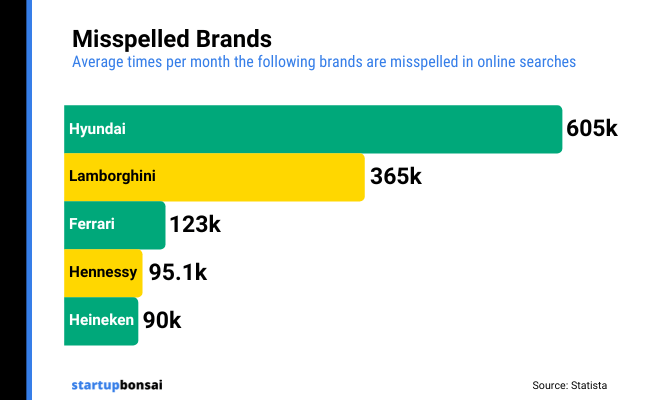
Source: Statista
Social media branding statistics
Posting on social media is one of the best ways for companies to build a strong brand image and following. Here are some statistics relating to branding on social media.
22. 77% of consumers choose to buy from brands they follow on social media over buying from other brands
Social media marketing is an extremely important tool when it comes to branding. It provides brands with a direct link to their customers and can break down the divide between consumers and businesses.
Not only this, but social media users love to follow their favorite brands on social media, and it has a big impact on their purchasing decisions too.
According to Sprout Social, almost 80% of consumers buy products from brands they follow online over products from brands they don’t follow. This really highlights the importance of brands having a strong social media following.
Source: Sprout Social
23. 48% of customers want to be entertained by brands on social media
Although social media can be used for advertisements, it’s more useful to use it as a tool to build a strong brand image and strengthen customer relationships.
According to Sprout Social, around 50% of customers look to brands for entertainment on social media rather than just coupons or ads. This is interesting as it clearly evidences the way social media can be used to build stronger ties with potential customers.
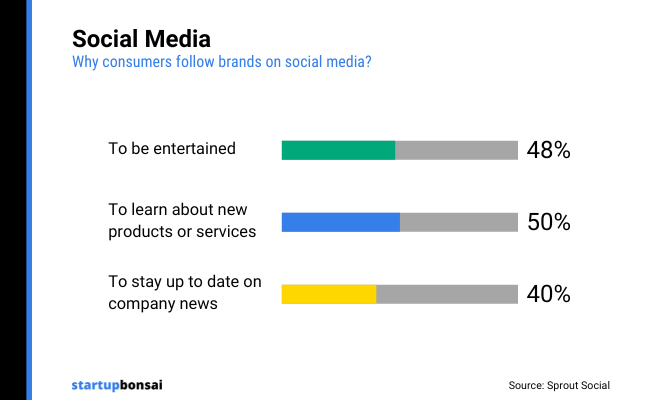
Source: Sprout Social
24. 43% of consumers unfollow brands that run too many social media ads
In fact, people actually prefer it when brands don’t post too many ads via social media. According to Sprout Social, 43% of consumers will actively unfollow brands if they feel bombarded by advertising or self-promotional content.
Again, this further evidences the idea that consumers follow brands for entertainment and information on social media, not to gain discounts or ads.
Source: Sprout Social
25. 59% of users say UGC is the most authentic type of social media content brands can share
To establish a significant brand presence on social media, it’s important to make sure you’ve nailed your content marketing and developed a strong social strategy. And as this stat shows, user-generated content (UGC) is one of the most important parts of your content mix as it’s seen as the most authentic.
If you didn’t already know, UGC is any type of content that’s created by your audience/customers themselves and ‘generated’ through your marketing campaigns.
For example, photos of real customers wearing/using your products out in the wild are a great type of UGC, as they serve as powerful social proof.
One easy way to generate UGC at scale is to run a social media contest in which your followers can enter for a chance to win a prize by sharing a picture of themselves featuring your products and captioning it with a branded hashtag.
Source: BusinessWire
26. 61% of people feel that the most trustable brand spokespeople on social media are people like themselves
Part of building a strong brand is finding ambassadors/spokespeople willing to endorse and promote your brand to their audience.
And as this stat shows, one of the most effective brand ambassadors you can have is someone that your customers can relate to. Someone that they feel like they have a lot in common with.
The only type of person surveyed consumers said they’d find even more credible as a brand spokesperson is scientists/academic experts (64%). Other brand ambassadors consumers would find credible include brand technical experts (53%) and regular employees (48%)
Source: Edelman
Branding challenges
Getting branding right isn’t always easy, especially when you take into account social changes and changes to consumer habits and spending. Here are some statistics that highlight the challenges brands are currently facing.
27. 71% of customers have switched brands at least once in the last year
According to a report from Salesforce, almost three-quarters of surveyed customers report switching brands over a 12-month period.
The main reason consumers switched was to get better deals (66%). However, branding also has an impact on brand defection, as 27% of those who switched said they did so because the brand they switched to better aligned with their values.
This shows the challenges brands face when it comes to customer retention. If you want to keep the customers you work hard to attain, you’ll likely need to invest heavily in efforts to bolster brand loyalty.
Make sure your values align closely with those of your customers and provide the best possible customer service, product availability, and deals that you can.
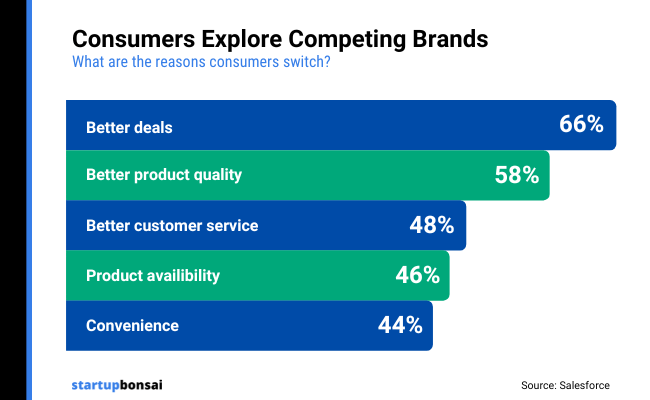
Source: Salesforce
28. 85% of consumers expect consistent interactions across different departments within businesses
Salesforce’s latest report found that consumers increasingly expect all interactions with a brand to be consistent, regardless of the department they’re dealing with.
85% said they expected this brand consistency last year, compared to 76% in 2020. And 83% say they’re more loyal to brands that achieve this.
Needless to say, then, providing consistent brand presentation seems to be crucial to creating a strong brand.
But despite its importance, this is proving to be a major challenge for brands, and the majority of companies are still falling short of the mark.
60% of surveyed consumers said they generally feel like they’re communicating with different departments rather than one company, and 66% said they often have to repeat the same information to different representatives.
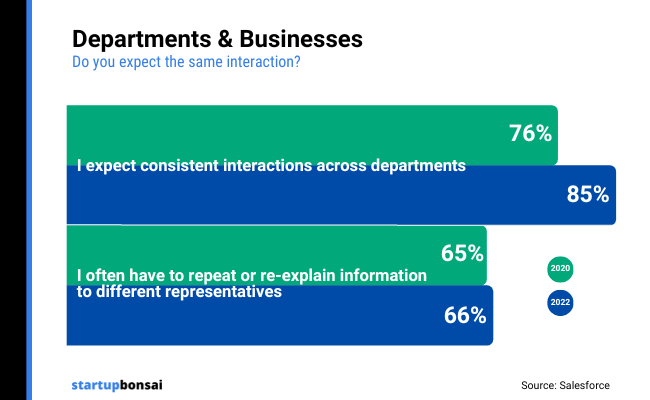
Source: Salesforce
29. 58% of people say they are now making fewer impulse purchases
Edelman found in a recent report that the disruptive events of the last few years (the covid pandemic, economic uncertainty, increasing political polarization, etc.) have heightened consumer vulnerability. And that increase in consumer vulnerability is having a knock-on effect on brands.
Brands are under more scrutiny now than they were a couple of years ago. And the majority of consumers say that given the events of the past year, they’re now doing more research before they buy and making fewer impulse purchases.
To offset these more conservative consumer spending habits, companies must work harder to create a strong brand that attracts and retains customers. But that’s easier said than done.
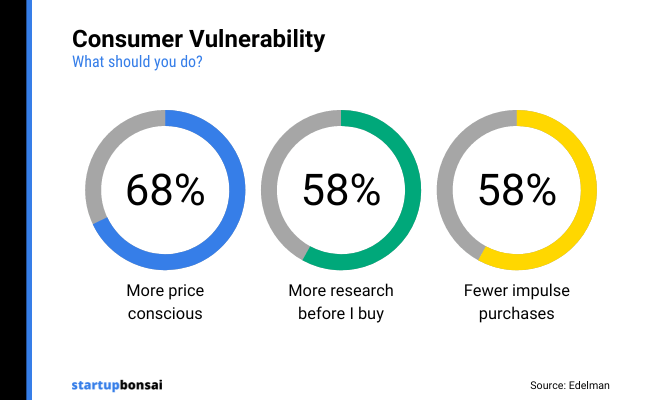
Source: Edelman
30. 76% of consumers say engagements go wrong when brands are unwanted, exploitative, or intrusive
Engaging with your customers is an important part of building a strong brand. But all too often, brands get engagement wrong, which can have the opposite effect
And the biggest problem seems to be a lack of authenticity or relevance in their consumer interactions.
According to the 2023 Edelman Trust Barometer study, 76% of surveyed consumers said that when a brand’s attempt to engage/interact with them goes wrong, it’s usually because their interactions lack relevance (i.e., they’re unwanted or intrusive).
A further 51% said attempts to engage go wrong because their interactions lack authenticity (i.e. they’re uninteresting, inauthentic, or out of touch).
Interestingly, younger generations were more likely to point to a lack of relevance and authenticity as the main problem than older generations, suggesting that there may be a disconnect between many brands and the wants/needs of the new generation of consumers.
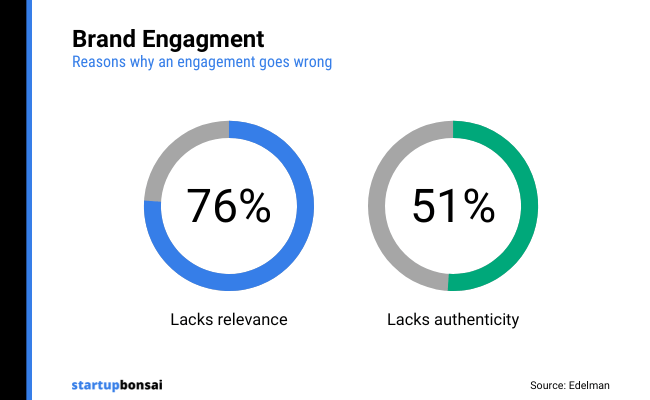
Source: Edelman
Sources
- Salsify
- BusinessWire
- Salesforce
- Sprout Social
- Sprout Social 2
- Reboot Online
- Marketsmiths
- Kinesis Inc
- Statista
- Edelman
Final thoughts
So there you have it, an extensive list of the most important branding statistics to know this year.
As you can see, customers value authenticity and trustworthiness highly, so it’s important to build a transparent and consistent branding strategy if you want to form long-term relationships with customers.
Not only that, but consumers love to build strong links with brands by following them on social media, so it’s a good idea to ensure your business has a strong social media presence.
If you’re keen to learn more about social media or building a brand strategy for your business, be sure to check out some of our other posts.
Looking for more stats? You may find these articles helpful:
